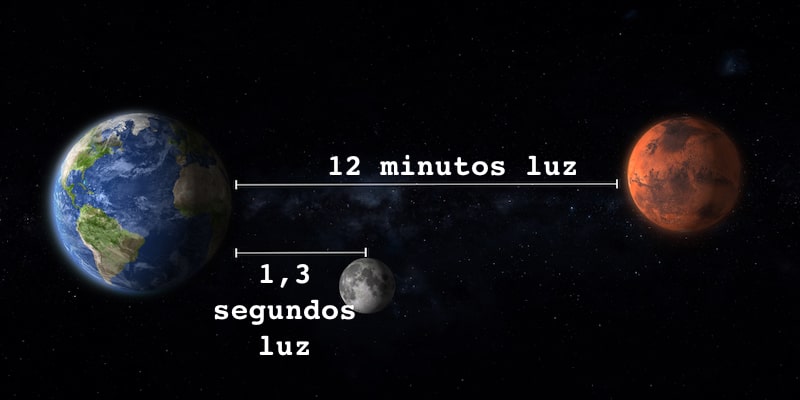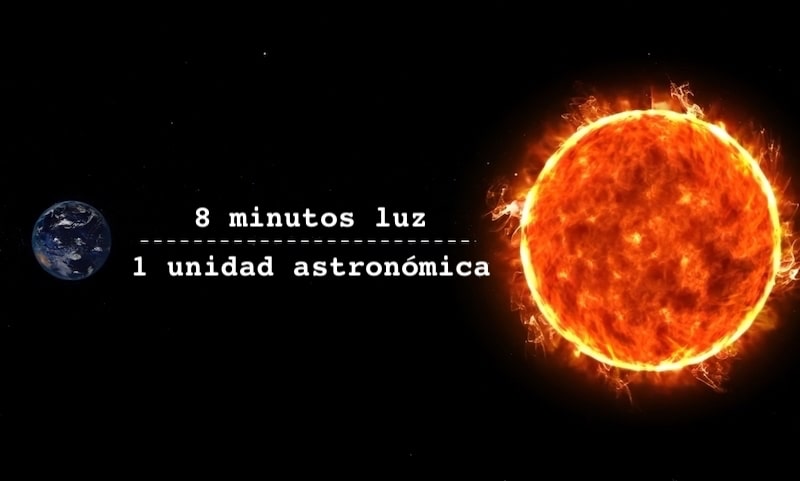We explain what a light year is and indicate various distances measured in light years. Also, what other units are used in astronomy.

What is a light year?
One light year (also written light-year) It is a unit of astronomical length, whose value is equivalent to the distance that a photon or light particle travels in a vacuum in a period of one year that is, 9.46 x 1012 km or 9,460,730,472,580.8 km. It is a unit created to measure great sidereal distances, which cover billions of kilometers and therefore require a particular measurement to express such distances in a simple way.
According to the International Astronomical Union, the exact definition of a light year (abbreviated ly either ly for its acronym in English, light year) must take into account for its measurement the Julian calendar (instead of the Gregorian) and the speed of light (calculated at 299,792,458 m/s). This means that the year during which light would be traveling a distance in space would be equivalent to 365.25 days (and not 365.2425 as in the Gregorian calendar).
As with other units of distance, the light year can be taken to its respective multiples, adding just a prefix to the name of the figure: kilo-light years (kly) for 1000 light years, for example, or mega-light years (gly) for 1,000,000 light years.
See also: Universe
Origin of the light year
The light year unit was invented in the mid-19th century, when The German mathematician and astronomer Friedrich Bessel (1784-1846) accurately measured the distance from the Earth to a star other than the Sun for the first time which was 61 Cygni, in the constellation of the Swan. This distance was equivalent to 98,734,594,662 kilometers or 61,350,985,287.1 miles, very cumbersome figures to handle, so Bessel preferred to express them in the time it takes for light to travel that distance that is, 10.3 years.
Since at that time the speed of light had not been firmly calculated, Bessel preferred not to use the unit of light-year, which was done decades later, in 1851, by the German popular science writer Otto Ule (1820-1876). , in an article where he explained that a “light year” should be used in the same way as an “hour of walking.”
Originally, the light-year was considered an astronomical unit typical of the German academy, and there were those who opposed its use, such as the British astrophysicist Arthur Eddington (1882-1944), who considered it inconvenient and irrelevant, typical of popular use and of popular science.
Some spatial distances in light years
Expressed in light-years, some of the most relevant spatial distances are:
- The diameter of the Milky Way, our galaxy, is approximately 150,000 light years. In contrast, the diameter of its sister galaxy, Andromeda, is 240,000 light years. Both galaxies are separated by 2,500,000 light years.
- The distance between the Sun and the Oort Cloud at the edge of the solar system is approximately 1 light year.
- The distance between the Sun and the nearest star, Proxima Centauri, is 4.22 light years.
- The distance between the Milky Way and the nearest galaxy, the Canis Major dwarf galaxy, is 25,000 light years.
- The approximate diameter of the Local Group of galaxies, to which the Milky Way belongs, is 10,000,000 light years.
- The approximate diameter of the Virgo supercluster, to which the Local Group of galaxies belongs, is 200,000,000 light years.
- The approximate diameter of the Pisces-Cetus supercluster complex, to which the Virgo supercluster belongs, is 1,000,000,000 light years.
- The approximate diameter of the largest observable astronomical structure in the universe, the Great Wall of Hercules-Corona Borealis, exceeds 10,000,000,000 light years.
Other astronomical units such as the light year
In addition to the light year, There are other astronomical units that are used to express great distances that separate bodies and spatial structures. Some of them derive from the light year itself, such as the light-month, the light-day, the light-hour, the light-minute and the light-second, which are governed by the same principle and are used in the popular science or in telecommunications and relativistic physics.
Other astronomical units, however, are larger than the light year and are preferred by astronomical specialists. Such is the case of:
- The parsec (pc) equivalent to 3.2616 light years, its name comes from English parallax of one arc second (“parallax of one arc second”).
- The astronomical unit (AU) equivalent to 8 light minutes, is determined by the average distance between the Earth and the Sun.
Differences between light year and astronomical unit

The astronomical unit is the unit preferred by astronomical scholars, since its magnitude is relatively fixed and expressible in much simpler terms. Instead, the exact value of the light year depends on different contextual considerations, such as whether light propagates in a vacuum, whether the year is measured by the Julian and not the Gregorian calendar, among others.
The light year, therefore, is a less exact and more complicated unit. On the other hand, it has in its favor that it is very illustrative of the enormous sidereal distances, since it is known that light travels faster than anything else in the universe.
Continue with: International System of Units
References
- “Astronomical unit” in Wikipedia.
- “What is a light year?” at NASA Space Place.
- “Light-year (astronomy)” in The Encyclopaedia Britannica.





